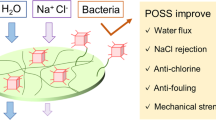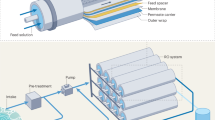Abstract
Chlorination is a common practice to prevent biofouling in municipal water supplies, wastewater reuse and seawater desalination. However, polyamide thin-film composite reverse osmosis membranes—the premier technology for desalination and clean-water production—structurally deteriorate when continually exposed to chlorine species. Here, we use layer-by-layer interfacial polymerization of 3,5-dihydroxybenzoic acid with trimesoyl chloride to fabricate a polyester thin-film composite reverse osmosis membrane that is chlorine-resistant in neutral and acidic conditions. Strong steric hindrance and an electron-withdrawing group effectively prevent direct aromatic chlorination, and residual OH groups capped with isophthaloyl dichloride preclude reaction with active chlorine. The poly(isophthalester) membrane exhibits high salt rejection (99.1 ± 0.2%) and water permeability (2.97 ± 0.13 l m−2 h−1 bar−1), even after demonstrating biofouling prevention with chlorine (50 mg l−1 of NaOCl for 15 min). We anticipate that our chlorine-resistant membrane will greatly advance reverse osmosis desalination as a sustainable technology to meet the global challenge of water supply.
This is a preview of subscription content, access via your institution
Access options
Access Nature and 54 other Nature Portfolio journals
Get Nature+, our best-value online-access subscription
$29.99 / 30 days
cancel any time
Subscribe to this journal
Receive 12 digital issues and online access to articles
$119.00 per year
only $9.92 per issue
Buy this article
- Purchase on Springer Link
- Instant access to full article PDF
Prices may be subject to local taxes which are calculated during checkout




Similar content being viewed by others
Data availability
Data are available upon reasonable request from the authors, according to their contributions. Source data are provided with this paper.
References
Phillip, W. A. & Elimelech, M. The future of seawater desalination: energy, technology, and the environment. Science 333, 712–717 (2011).
Mauter, M. S. et al. The role of nanotechnology in tackling global water challenges. Nat. Sustain. 1, 166–175 (2018).
Stevens, D. M., Shu, J. Y., Reichert, M. & Roy, A. Next-generation nanoporous materials: progress and prospects for reverse osmosis and nanofiltration. Ind. Eng. Chem. Res. 56, 10526–10551 (2017).
Werber, J. R., Osuji, C. O. & Elimelech, M. Materials for next-generation desalination and water purification membranes. Nat. Rev. Mater. 1, 16018–16025 (2016).
Qasim, M., Badrelzaman, M., Darwish, N. N., Darwish, N. A. & Hilal, N. Reverse osmosis desalination: a state-of-the-art review. Desalination 459, 59–104 (2019).
Chowdhury, M. R., Steffes, J., Huey, B. D. & McCutcheon, J. R. 3D printed polyamide membranes for desalination. Science 361, 682–686 (2018).
Gohil, J. M. & Suresh, A. K. Chlorine attack on reverse osmosis membranes: mechanisms and mitigation strategies. J. Membr. Sci. 541, 108–126 (2017).
Verbeke, R., Gómez, V. & Vankelecom, I. F. J. Chlorine-resistance of reverse osmosis (RO) polyamide membranes. Prog. Polym. Sci. 72, 1–15 (2017).
Stolov, M. & Freger, V. Degradation of polyamide membranes exposed to chlorine: an impedance spectroscopy study. Environ. Sci. Technol. 53, 2618–2625 (2019).
Do, V. T., Tang, C. Y., Reinhard, M. & Leckie, J. O. Effects of chlorine exposure conditions on physiochemical properties and performance of a polyamide membrane-mechanisms and implications. Environ. Sci. Technol. 46, 13184–13192 (2012).
Glater, J., Hong, N. & Elimelech, M. The search for a chlorine-resistant reverse osmosis membrane. Desalination 95, 325–345 (1994).
Werber, J. R., Deshmukh, A. & Elimelech, M. The critical need for increased selectivity, not increased water permeability, for desalination membranes. Environ. Sci. Technol. 3, 112–120 (2016).
Tanugi, D. C., McGovern, R. K., Dave, S. H., Lienhard, J. H. & Grossman, J. C. Quantifying the potential of ultra-permeable membranes for water desalination. Energy Environ. Sci. 7, 1134–1141 (2014).
Yao, Y. et al. Toward enhancing the chlorine resistance of reverse osmosis membranes: an effective strategy via an end-capping technology. Environ. Sci. Technol. 53, 1296–1304 (2019).
Hu, J., Pu, Y., Ueda, M., Zhang, X. & Wang, L. Charge-aggregate induced (CAI) reverse osmosis membrane for seawater desalination and boron removal. J. Membr. Sci. 520, 1–7 (2016).
Yao, Y. et al. A novel sulfonated reverse osmosis membrane for seawater desalination: Experimental and molecular dynamics studies. J. Membr. Sci. 550, 470–479 (2018).
Zheng, J. et al. Reverse osmosis membrane with enhanced permselectivity for brackish water desalination. J. Membr. Sci. 565, 104–111 (2018).
Cheremisinoff, N. P. Condensed Encyclopedia of Polymer Engineering Terms (Butterworth–Heinemann, 2001).
Wu, D., Chen, F., Li, R. & Shi, Y. Reaction kinetics and simulations for solid-state polymerization of poly(ethylene terephthalate). Macromolecules 30, 6737–6742 (1997).
Krevelen, D. W. V. & Nijenhuis, K. T. in Properties of Polymers: Their Correlation with Chemical Structure; their Numerical Estimation and Prediction from Additive Group Contributions Ch. 7 (Elsevier, 2009).
Lide, D. R. Handbook of Chemistry and Physics (CRC Press, 2010).
Kuang, J. et al. Ozonation of trimethoprim in aqueous solution: identification of reaction products and their toxicity. Water Res. 47, 2863–2872 (2013).
Miao, H. F. et al. Degradation of phenazone in aqueous solution with ozone: influencing factors and degradation pathways. Chemosphere 119, 326–333 (2015).
Park, H., Vecitis, C. D. & Hoffmann, M. R. Electrochemical water splitting coupled with organic compound oxidation: the role of active chlorine species. J. Phys. Chem. C 113, 7935–7945 (2009).
Jimenez-Solomon, M., Song, Q., Jelfs, K., Munoz-Ibanez, M. & Livingston, A. G. Polymer nanofilms with enhanced microporosity by interfacial polymerization. Nat. Mater. 15, 760–767 (2016).
Antony, A., Fudianto, R. & Cox, S. Assessing the oxidative degradation of polyamide reverse osmosis membrane—accelerated ageing with hypochlorite exposure. J. Membr. Sci. 347, 159–164 (2010).
Huang, K. et al. Reactivity of the polyamide membrane monomer with free chlorine: reaction kinetics, mechanisms, and the role of chloride. Environ. Sci. Technol. 53, 8167–8176 (2019).
Do, V. T., Tang, C. Y., Reinhard, M. & Leckie, J. O. Degradation of polyamide nanofiltration and reverse osmosis membranes by hypochlorite. Environ. Sci. Technol. 46, 852–859 (2012).
Xu, G. R., Wang, J. N. & Li, C. J. Strategies for improving the performance of the polyamide thin film composite (PA-TFC) reverse osmosis (RO) membranes: surface modifications and nanoparticles incorporations. Desalination 328, 83–100 (2013).
Asadollahi, M., Bastani, D. & Musavi, S. A. Enhancement of surface properties and performance of reverse osmosis membranes after surface modification: a review. Desalination 420, 330–383 (2017).
Park, H., Freeman, B. D., Zhang, Z., Sankir, M. & McGrath, J. E. Highly chlorine-tolerant polymers for desalination. Angew. Chem. Int. Ed. 47, 6019–6024 (2008).
Law, S. K. A., Minich, T. M. & Levine, R. P. Covalent binding efficiency of the third and fourth complement proteins in relation to pH, nucleophilicity, and availability of hydroxyl groups. Biochemistry 23, 3267–3272 (1984).
FILMTECTM Reverse Osmosis Membranes Technical Manual Form No.45-D01696-en, Rev. 4, 2020; Cleaning procedures for FilmTec™ FT30 Elements (Dow, 2020); https://www.dupont.com/products/filmtecsw302514.html
She, Q., Wang, R., Fane, A. G. & Tang, C. Y. Membrane fouling in osmotically driven membrane processes: a review. J. Membr. Sci. 499, 201–233 (2016).
Acknowledgements
This work was supported by the National Natural Science Foundation of China (21774058), the Natural Science Foundation of Jiangsu Province (BK20180072) and the Fundamental Research Funds for the Central Universities (NUST 30918012201, 30920021119). We also acknowledge the US National Science Foundation through the Engineering Research Center for Nanotechnology-Enabled Water Treatment (EEC1449500) and the American Water Works Association Abel Wolman Fellowship awarded to R.M.D.
Author information
Authors and Affiliations
Contributions
X.Z. conceived the initial idea and experimental design. X.Z. and M.E. supervised the study and experiments. Y.Y. performed the membrane fabrication and characterization experiments. P.Z. and C.J. carried out the molecular dynamics simulations and analysed the data. All authors analysed results and commented on the manuscript. Y.Y., X.Z., R.M.D. and M.E. wrote the paper with help from all authors.
Corresponding authors
Ethics declarations
Competing interests
X.Z. and Y.Y. are inventors on patent applications (201911277839.9 and 201911270642.2) submitted by Nanjing University of Science and Technology, which cover the fabrication of polyester RO membranes. All other authors have no competing interests.
Additional information
Publisher’s note Springer Nature remains neutral with regard to jurisdictional claims in published maps and institutional affiliations.
Supplementary information
Supplementary Information
Supplementary Figs. 1–18, Tables 1–8 and Notes 1–9.
Source data
Source Data Fig. 2
Desalination performance, micro-scale morphology and DFT simulation results for fabricated polyester membranes.
Source Data Fig. 3
Performance and morphology of PIP-DHBA-DHBA and SW30 membranes after chlorine exposure.
Source Data Fig. 4
Performance recovery of fouled PIP-DHBA-DHBA and SW30 membranes after chlorine exposure.
Rights and permissions
About this article
Cite this article
Yao, Y., Zhang, P., Jiang, C. et al. High performance polyester reverse osmosis desalination membrane with chlorine resistance. Nat Sustain 4, 138–146 (2021). https://doi.org/10.1038/s41893-020-00619-w
Received:
Accepted:
Published:
Issue Date:
DOI: https://doi.org/10.1038/s41893-020-00619-w
This article is cited by
-
Pressure-driven membrane desalination
Nature Reviews Methods Primers (2024)
-
Ultrastable ceramic-based metal–organic framework membranes with missing linkers for robust desalination
Nature Water (2024)
-
Machine learning for membrane design in energy production, gas separation, and water treatment: a review
Environmental Chemistry Letters (2024)
-
Anomalous water molecular gating from atomic-scale graphene capillaries for precise and ultrafast molecular sieving
Nature Communications (2023)
-
Ceramic thin-film composite membranes with tunable subnanometer pores for molecular sieving
Nature Communications (2023)



